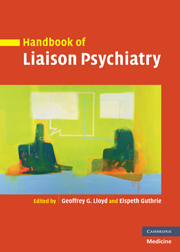Book contents
- Frontmatter
- Contents
- List of contributors
- Preface
- Part I Basic skills
- Part II Common psychiatric problems across the general hospital
- Part III Working with specific units
- Part IV Treatment
- Part V Different treatment settings
- 36 Developing links with primary care
- 37 Frequent attenders in primary care
- 38 Major disaster planning
- Index
- References
38 - Major disaster planning
from Part V - Different treatment settings
Published online by Cambridge University Press: 10 December 2009
- Frontmatter
- Contents
- List of contributors
- Preface
- Part I Basic skills
- Part II Common psychiatric problems across the general hospital
- Part III Working with specific units
- Part IV Treatment
- Part V Different treatment settings
- 36 Developing links with primary care
- 37 Frequent attenders in primary care
- 38 Major disaster planning
- Index
- References
Summary
Introduction
In the last few decades there have been a number of high-profile disasters, memories of which can be evoked by the mention of a place name. For example, Zeebrugge, Lockerbie, Bradford, Bali, New York and Madrid. Disasters affect many people. Victims and their families, survivors, witnesses and the personnel of agencies involved in the emergency response are perhaps the most obvious groups, but disasters often affect whole communities, countries and, as we have seen following the terrorist attacks on 11 September 2001, the whole world.
Emergency plans
There have been criticisms regarding the unplanned and uncoordinated nature of psychosocial input following several disasters, leading to calls for the creation of multiagency planning groups that include mental health professionals to plan appropriate responses before disasters occur (Bisson 2003). Every local authority in England and Wales has an emergency planning officer whose key role is to develop an emergency plan. The emergency planning officer co-ordinates the Disaster Management System, a multiagency, multiprofessional partnership with the emergency services (ambulance, fire and police) being central to it. Other agencies including the local authority, social services, health services and voluntary agencies support the emergency services. In order for their input to be effective this support should be delivered in a preplanned co-ordinated manner integrated into the central plan.
Disaster plans often include a well-developed ‘non-psychological’ emergency response but little, if any, detail about the psychological response, perhaps reflecting the Home Office's (1998) Dealing with Disasters document that merely states ‘victims of disasters should be offered psychological support’.
Keywords
- Type
- Chapter
- Information
- Handbook of Liaison Psychiatry , pp. 896 - 912Publisher: Cambridge University PressPrint publication year: 2007



